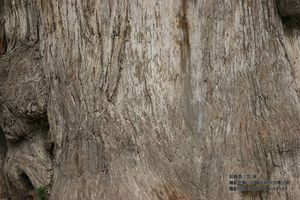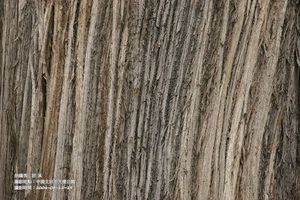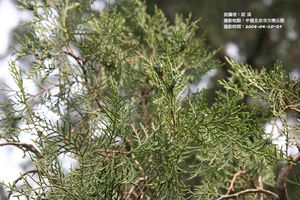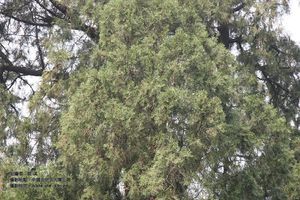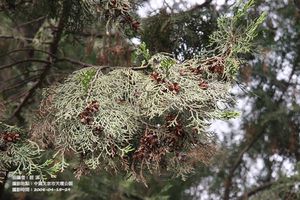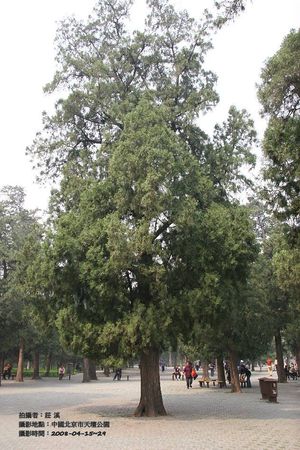側柏
出自台灣有毒中草藥毒性資料庫
| 第9行: | 第9行: | ||
||[http://tcm-toxic.kmu.edu.tw/index.php/%E7%97%87%E7%8B%80 症狀] | ||[http://tcm-toxic.kmu.edu.tw/index.php/%E7%97%87%E7%8B%80 症狀] | ||
|} | |} | ||
| - | {{:模板:基本資料|1=柏科Cupressaceae|2=側柏屬|3= 'Thuja'|4=側柏|5=''Platycladus orientalis'' (L.) Franco. | + | {{:模板:基本資料|1=柏科Cupressaceae|2=側柏屬|3= 'Thuja'|4=側柏|5= |
| - | + | ''Platycladus orientalis'' (L.) Franco. | |
| - | ''Biota orientalis'' (L.) Endl. | + | *''Biota orientalis'' (L.) Endl. |
| - | + | *''Thuja orientalis'' L. | |
| - | ''Thuja orientalis'' L. | + | |
|6=Chinese Arbor vitae, oriental Arbor Vitae|7=柏樹、扁柏、香柏、扁檜、黃心柏、香樹}} | |6=Chinese Arbor vitae, oriental Arbor Vitae|7=柏樹、扁柏、香柏、扁檜、黃心柏、香樹}} | ||
| 第125行: | 第124行: | ||
*6. 神經保護作用(neuroprotective)[7]</font> <font size=4> | *6. 神經保護作用(neuroprotective)[7]</font> <font size=4> | ||
**在0.1-10 μM之間,(–)-savinin, (–)-hinokinin, dehydroheliobuphthalmin都能顯著的有效抑制glutamine引起的神經傷害。</font> | **在0.1-10 μM之間,(–)-savinin, (–)-hinokinin, dehydroheliobuphthalmin都能顯著的有效抑制glutamine引起的神經傷害。</font> | ||
| + | |||
== '''毒性研究''' == | == '''毒性研究''' == | ||
| 第160行: | 第160行: | ||
1. 臺灣大百科全書 側柏. http://taiwanpedia.culture.tw/web/content?ID=25135 | 1. 臺灣大百科全書 側柏. http://taiwanpedia.culture.tw/web/content?ID=25135 | ||
| - | 2. Fan SY, Zeng HW, Pei YH et al. The anti-inflammatory activities of an extract and compounds isolated from Platycladus orientalis (Linnaeus) Franco in vitro and ex vivo. Journal of Ethnopharmacology 2012; 141: 647-652. | + | 2. Fan SY, Zeng HW, Pei YH et al. [http://www.ncbi.nlm.nih.gov/pubmed/21619922 The anti-inflammatory activities of an extract and compounds isolated from Platycladus orientalis (Linnaeus) Franco in vitro and ex vivo.] ''Journal of Ethnopharmacology'' 2012; 141: 647-652. |
| - | 3. Kim CS, Choi SU, Lee KR. Three new diterpenoids from the leaves of Thuja orientalis. Planta medica 2012; 78: 485-487. | + | 3. Kim CS, Choi SU, Lee KR. [http://www.ncbi.nlm.nih.gov/pubmed/22294263 Three new diterpenoids from the leaves of Thuja orientalis.] ''Planta medica'' 2012; 78: 485-487. |
| - | 4. Lee MK, Yang H, Yoon JS et al. Antifibrotic activity of diterpenes from Biota orientalis leaves on hepatic stellate cells. | + | 4. Lee MK, Yang H, Yoon JS et al. [http://www.ncbi.nlm.nih.gov/pubmed/18704328 Antifibrotic activity of diterpenes from Biota orientalis leaves on hepatic stellate cells.] ''Archives of Pharmacal Research'' 2008; 31: 866-871. |
| - | 5. Guleria S, Kumar A, Tiku AK. Chemical composition and fungitoxic activity of essential oil of Thuja orientalis L. grown in the north-western Himalaya. | + | 5. Guleria S, Kumar A, Tiku AK. [http://www.ncbi.nlm.nih.gov/pubmed/18533464 Chemical composition and fungitoxic activity of essential oil of Thuja orientalis L. grown in the north-western Himalaya.] ''Journal of Biosciences'' 2008; 63: 211-214. |
| - | 6. Xu GH, Ryoo IJ, Kim YH et al. Free radical scavenging and antielastase activities of flavonoids from the fruits of Thuja orientalis. | + | 6. Xu GH, Ryoo IJ, Kim YH et al. [http://www.ncbi.nlm.nih.gov/pubmed/19280159 Free radical scavenging and antielastase activities of flavonoids from the fruits of Thuja orientalis.] ''Archives of Pharmacal Research'' 2009; 32: 275-282. |
| - | 7. Yoon JS, Koo KA, Ma CJ et al. Neuroprotective Lignans from Biota orientalis leaves. Natural Product Sciences 2008; 14: 167-170. | + | 7. Yoon JS, Koo KA, Ma CJ et al. [http://agris.fao.org/agris-search/search/display.do?f=2010/KR/KR1001.xml;KR2009002563 Neuroprotective Lignans from Biota orientalis leaves.] ''Natural Product Sciences'' 2008; 14: 167-170. |
| - | 8. Millet Y, Jouglard J, Steinmetz MD et al. Toxicity of some essential plant oils. Clinical and experimental study. Clinical Toxicology 1981; 18: 1485-1498. | + | 8. Millet Y, Jouglard J, Steinmetz MD et al. [http://www.ncbi.nlm.nih.gov/pubmed/7333081 Toxicity of some essential plant oils. Clinical and experimental study.] ''Clinical Toxicology'' 1981; 18: 1485-1498. |
| - | 9. Fiorina A, Scordamaglia A, Fumagalli F et al. Aerobiological diagnosis of respiratory allergy by a personal sampler: two case reports. | + | 9. Fiorina A, Scordamaglia A, Fumagalli F et al. [http://www.ncbi.nlm.nih.gov/pubmed/14989120 Aerobiological diagnosis of respiratory allergy by a personal sampler: two case reports.] ''Journal of investigational allergology & clinical immunology'' 2003; 13: 284-285. |
</font> | </font> | ||
在2012年10月30日 (二) 13:03所做的修訂版本
| 中英文學名 | 科別 | 毒性 | 症狀 |
基本資料
|
科別 | 柏科Cupressaceae |
|
屬名 | 側柏屬 Thuja |
|
中文學名 | 側柏 |
|
拉丁學名 | Platycladus orientalis (L.) Franco.
|
|
英文名稱 | Chinese Arbor vitae, oriental Arbor Vitae |
|
中文俗名 | 柏樹、扁柏、香柏、扁檜、黃心柏、香樹 |
植物圖片
|
側柏莖1 |
側柏莖2 |
側柏葉1 | |
|
側柏葉2 |
側柏果實 |
側柏全株 |
側柏簡介
側柏原產於中國西部及北部,台灣引進作為造景之用。側柏主要是以葉及隻枝入藥,但兩者皆有毒性,人畜皆會中毒,主要是引起噁心嘔吐等作用,嚴重症狀可能產生肺水腫,肌肉痙攣,呼吸循環衰竭。中醫取其枝葉,用於利尿,止血及整腸健胃等[1]。
外觀簡述
|
莖 | 株高 20 公尺,胸徑 1 公尺,樹皮淺灰色,條裂成薄片;枝條開展,小枝扁平,排列成複葉狀。 |
|
葉 | 葉全為鱗片狀,長 0.1~0.3 公分,交互對生。 |
|
花 | 雌雄同株,球花生於枝頂;雄球花有 6 對交互對生的雄蕊,花藥 2~4;雌球花有 4 對交互對生的珠鱗,僅中間兩對珠鱗各有胚珠 1~2 枚。花期 4~5 月。 |
|
果實 | 毬果當年成熟,熟時開裂,卵球形,徑 1.5~2 公分;種鱗 4 對,木質,近扁平,背部上方有一彎曲的鉤狀尖頭,中部種鱗各有 1~2 粒種子;種子長卵形,長約 0.4 公分,子葉 2,發芽時出土。當年 10 月毬果成熟。 |
產地
中國大陸北部,中國各寺廟、公園廣為種植。
使用情況
側柏在台灣多數用於庭園造景之用,莖幹部分也用於木材建築之用,是屬於很好的建築木材。醫療用途則用於治咯血,胃腸道出血,尿血,功能性子宮出血,慢性氣管炎,脫髮。
活性成份
|
葉[2-8] |
|
活性研究
- 1. 抗發炎(anti-inflammatory) [2]
- in vitro & ex vivo:給予老鼠巨噬細胞(RAW 264.7細胞株)側柏的氯仿萃取物(CHL)和活性成分hinokiol及acacetin,顯著的抑制5-hydroxy-eicosa-tetra-enoic acid (5-HETE)及leukotrieneB4 (LTB4)形成。Cell-free assays指出CHL和hinokiol及acacetin可抑制5-lipoxygenase (5-LOX)。同時,CHL及hinokiol也會抑制NO的生合成(biosynthesis),CHL, 8(14),15-pimaradien-3β,18-diol及hinokiol則是抑制腫瘤壞死因子α(TNF-α)的釋出。
- 2. 抗纖維化(antifibrotic activity)[4]
- 3. 抗黴菌[5]
- 側柏葉活性成分之一α-cedrol的抑菌(Alternaria alternata)最小抑菌劑量為30.5 μg。
- 4. 抗氧化作用
- 以DPPH scavenging assay測試(+)-catechin, quercitrin, hypolaetin 7-O -β -xylopyranoside, isoquercitrin, myricitrin;IC50分別為28.66, 31.19, 18.30, 26.63 15.10 μM;而以ABTS scavenging assay測試的IC50則分別為6.77, 13.96, 6.97, 22.79 and 9.96 μM [6]。
- 5. 抗蛋白質酶(antielastase activity)
- 測試cupressuflavone, amentoflavone, robustaflavone對human neutrophil elastase的抑制效果,IC50分別為8.09, 1.27及1.33 μM[6]。
- 6. 神經保護作用(neuroprotective)[7]
- 在0.1-10 μM之間,(–)-savinin, (–)-hinokinin, dehydroheliobuphthalmin都能顯著的有效抑制glutamine引起的神經傷害。
毒性研究
- 症狀
- 1. 強直陣攣性痙攣(tonico-clonic convulsion)[8]
- 有毒成分
- 1. thujone[8]
- 中毒劑量
- 未知
- 機轉
- 未知
- 神經毒性
- 1. Millet et al.報導病患使用市售側柏精油產品後,產生強直陣攣性痙攣[8] Commercial preparations of essences of sage, hyssop, thuja, and cedar。
- 過敏
- 1. 病患接觸到側柏的花粉後,引起氣喘發生[9]。
毒性分級
參考文獻
1. 臺灣大百科全書 側柏. http://taiwanpedia.culture.tw/web/content?ID=25135
2. Fan SY, Zeng HW, Pei YH et al. The anti-inflammatory activities of an extract and compounds isolated from Platycladus orientalis (Linnaeus) Franco in vitro and ex vivo. Journal of Ethnopharmacology 2012; 141: 647-652.
3. Kim CS, Choi SU, Lee KR. Three new diterpenoids from the leaves of Thuja orientalis. Planta medica 2012; 78: 485-487.
4. Lee MK, Yang H, Yoon JS et al. Antifibrotic activity of diterpenes from Biota orientalis leaves on hepatic stellate cells. Archives of Pharmacal Research 2008; 31: 866-871.
5. Guleria S, Kumar A, Tiku AK. Chemical composition and fungitoxic activity of essential oil of Thuja orientalis L. grown in the north-western Himalaya. Journal of Biosciences 2008; 63: 211-214.
6. Xu GH, Ryoo IJ, Kim YH et al. Free radical scavenging and antielastase activities of flavonoids from the fruits of Thuja orientalis. Archives of Pharmacal Research 2009; 32: 275-282.
7. Yoon JS, Koo KA, Ma CJ et al. Neuroprotective Lignans from Biota orientalis leaves. Natural Product Sciences 2008; 14: 167-170.
8. Millet Y, Jouglard J, Steinmetz MD et al. Toxicity of some essential plant oils. Clinical and experimental study. Clinical Toxicology 1981; 18: 1485-1498.
9. Fiorina A, Scordamaglia A, Fumagalli F et al. Aerobiological diagnosis of respiratory allergy by a personal sampler: two case reports. Journal of investigational allergology & clinical immunology 2003; 13: 284-285.
| 中英文學名 | 科別 | 毒性 | 症狀 |
